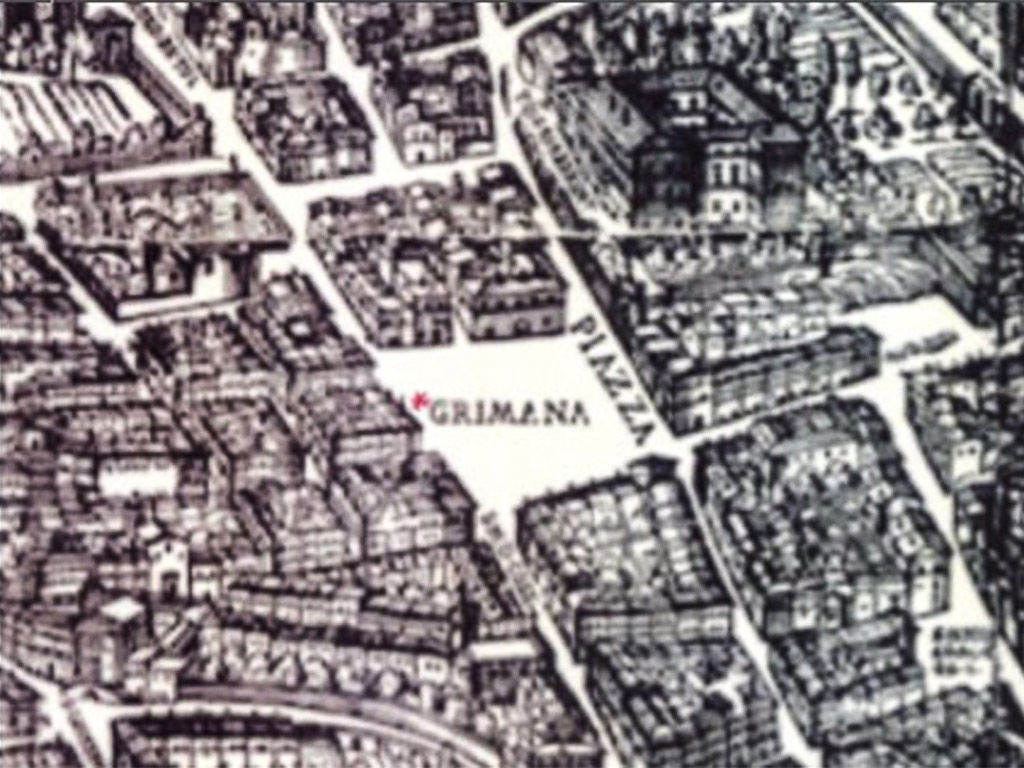
The building overlooks the square which, in the sixteenth century, did not yet bear the name of the imposing Palazzo Barberini, but was known by other names.
The name dating back to the mid-sixteenth century was “Piazza Grimana” because of a vineyard and a house owned by the patriarch of Aquileja, Cardinal Domenico Grimani. There is actually still a plaque in homage to Paul V at the corner with Via degli Avignonesi which recalls “the adjacent Grimana area”:
“PAULO V PONT OPT MAX OB ADIACENTEM AREAM GRIMANAM NUNCUPATAM GENS GRIMANA GRATI ANIMI MONUMENTUM FECIT”, “To Paul V Pontiff Ottimo Massimo, at the adjacent area called Grimana, the Grimana family erected it in memory of gratitude”.

Later, around 1625, the square took the name of “Sforza a Capo le Case”, in relation to the properties of Cardinal Sforza, which also included the villa of Cardinal Rodolfo Pio da Carpi, located in the Capo le Case area.
After Alessandro Sforza Santafiora, Duke of Segni, the land where Villa Carpi stood was purchased by Cardinal Francesco Barberini, who had the large palace erected.
The square was limited by modest houses with their vegetable gardens and gardens, by the large Barberini Palace and the court theater built by Bernini, hosting 2,000 seats, which remained in operation until 1873.

In 1642 Pope Urban VIII Barberini placed at the center of the square one of the most beautiful fountains in Rome, Fontana del Tritone (Bernini’s Triton fountain). In the second half of the nineteenth century, when Rome was still the state capital of the Church with the so-called “Pope King”, the building that today is Palazzo Caruso becomes property of the ancestors of the current owners: the Neapolitan Caruso family.
Mrs. Maria Balboni, the morganatic wife of Prince Doria d’Angri of Naples, inherits the precious property, which was only three floors high, while the family still lived permanently in Naples at the Palaces belonging to the Doria d’Angri family. It is in 1872 that Mrs. Maria Balboni requested the building to be modified and Palazzo Caruso becomes part of the progressive urban transformation of the area.

Upon her death, the building passes to her grandchildren Enrico (the famous tenor) Giuseppe and Elvira Caruso, grandmother of the current owner.
The Caruso family in the early 1900s moved in the capital. The family belongs to the class of Professionals and Artists of Rome and lives between the prestigious “Villa Stuart” on Monte Mario in Rome, currently transformed into the “Villa Stuart Nursing Home” and an attic in Palazzo Cerasi in Via del Babuino.

It is in this era that the Palace, no longer used as a family residence, becames a hotel taking the name of Hotel Des Anglais and then Hotel Pensione Pincio.
Following the disappearance of Elvira Caruso, the building became the property of her daughter Donna Maria Caruso, one of the first women to graduate in Architecture and Fine Arts in Italy, bride of the entrepreneur Lawyer Mario Cussino.

In the second half of the 1940s Maria Caruso, in a post-war context, changed the former use of the property to transform it into representative offices and in the following 90s his son, the architect Bruno Cussino becames its current owner.

Bruno Cussino, expert of recovery and restoration of historic buildings of ancient Rome, starting in 2013 undertook a long process of structural and typological functional restoration of Palazzo Caruso with the aim to bring it back to its former glory after the war.
In collaboration with his son Simonpietro, who took care of the aesthetic of the hotel balancing a mixture of modernity and restored historical furniture belonging to the family, in 2018 the palace reopened its doors becoming the actual Hotel Palazzo Caruso.